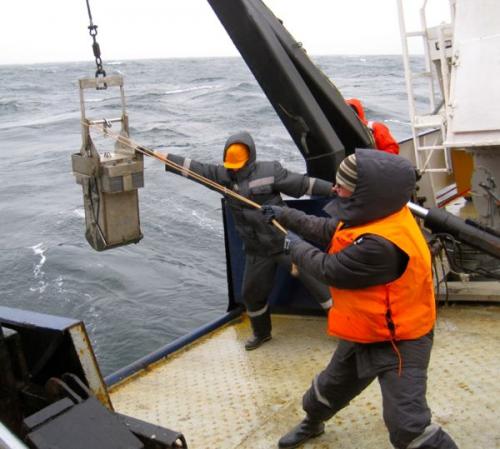After completing the lengthy first full station, everyone was ready for the next full station, scheduled to begin around noon yesterday. This one began with a productivity cast with the CTDA research tool that is submerged in the water to measure conductivity (salinity), temperature, and depth.. Primary productivity refers to the primary production of phytoplankton, the algae that photosynthesize and thus are the main producers in a food chain. During the "prod cast," Mike Kong, University of Alaska, and Jung-Woo Park and Jang Han Lee, from Korea, will collect water from the six different depths representing 100 % to 1 % light penetration. They´ll then add stable isotope tracers and incubate their samples on deck in bottles with screens that filter light to simulate various light depths. After an incubation period of three-five hours, they´ll filter the water, freeze the samples, and carry them home for analysis of the level of stable isotopes in each sample. By knowing the uptake of the isotope tracers, they'll be able to calculate how much the phytoplankton grew during the incubation time and then estimate their growth for the entire daylight period. While Jang and Jung-Woo are looking at the uptake of two keystone inorganic nutrients, nitrate and ammonia, Mike is looking at the uptake of organic nitrogen in the form of urea and amino acids. Although there's considerable information related to Jang and Jung-Woo's work, Mike's research target is relatively new and will provide baseline data for the future.
While others prepared their equipment, the team of Russian geologists deployed their large box core (to get sediments) over the starboard side. Although there is a gate there most of the time, it's impossible to get the large box core over the gate, and it was open as they worked. As the core was brought to the surface, it was clear that the weather was deteriorating rapidly. The winds had picked up to an estimated 40 knots, and the waves were running at 13-15 feet (again an estimation) with huge swells that washed water across the entire aft deck. If you check out the picture, you can see how cumbersome this piece of equipment is and, if you add in the weight of the mud when it's filled, it can become very unwieldy as it comes up out of the water and swings at the end of the winch wire. After seeing how difficult it was to get the box core on board, Jackie decided that the gate would remain closed for her vanVeen grabs (more about those in a later journal). She managed two grabs before everyone decided that the best bet was to cancel the remainder of the station, tie down as much equipment as possible, and go back inside. At that point, several people, me included, were feeling a bit seasick, and most retired to their bunks. Numbers were definitely down at dinner.
Throughout the night, Jackie and I heard things moving in our cabin. Both chairs tipped over and slid back and forth throughout the night. My metal water bottle rattled continuously, shoes slid across the room, and papers and assorted other items slid off the desk. When we got up this morning, we found that the doors to the decks had been shut and everyone was told to remain inside. With lots of water coming over the aft deck, the fish sorting table had been badly damaged, and other gear had shifted. It's definitely safer, at this point, to just wait this out.
Lunchtime provided a chance to catch up with some of the damage done by the wind and high waves. A fish sorting table had been badly damaged, the CTDA research tool that is submerged in the water to measure conductivity (salinity), temperature, and depth., although tied down tightly, had shifted and two of the bottles had been broken, one cooler on deck had overturned and dumped samples (fortunately not too many as it's early in the cruise), and a container had lost a lid and begun to fill with water bringing the bottles inside close to spilling out. Luckily someone caught them in time.



Comments